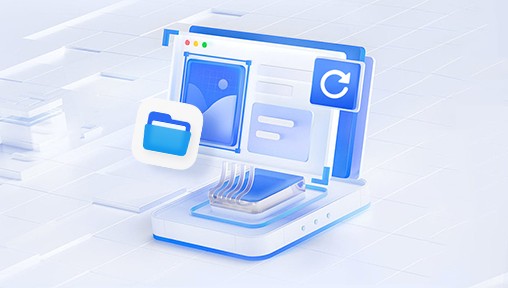When files are accidentally deleted from a computer, panic is a natural first reaction. Important work documents, cherished family photos, or critical system files can all vanish with a wrong click or mistaken command.
This means prompt action increases your chances of successful recovery. The less time that passes and the fewer new files created or downloaded after deletion, the better.
Methods to Recover Deleted Files on Windows
Check the Recycle Bin
The Recycle Bin is Windows’ first line of defense against accidental deletions. Files deleted using the Delete key or right-click “Delete” often go here first.

Double-click the Recycle Bin icon on your desktop.
Look through the files to see if your deleted file is listed.
Right-click the file and select “Restore.” It will return to its original location.
Files emptied from the Recycle Bin require more advanced methods.
Use Windows File History
If File History was enabled before deletion, it can be an excellent tool for recovery.
Navigate to the folder where the deleted file was located.
Right-click inside the folder and choose “Restore previous versions.”
Select the version from before the file was deleted.
Click “Restore” to bring the file back.
File History must be activated beforehand. If it wasn’t, Windows won’t have saved copies.
Recover Using Windows Backup
If you’ve set up Windows Backup, restoring deleted files becomes possible through Control Panel.
Go to Control Panel > System and Security > Backup and Restore (Windows 7).
Click “Restore my files.”
Browse or search for the files you want to recover.
Select and restore them to their original or a new location.
Windows Backup is useful for both personal and professional users who implement scheduled backups.
Utilize Windows Command Prompt (Attrib Command)
If you suspect files were hidden or made inaccessible rather than deleted, the attrib command might help.
Open Command Prompt as Administrator.
Type the following command and hit Enter:
attrib -h -r -s /s /d X:\*.*
Replace X with your drive letter.
This command unhides hidden and system files. It’s more of a troubleshooting method than a direct recovery solution.
Methods to Recover Deleted Files on Mac
Check the Trash
Similar to Windows’ Recycle Bin, Mac’s Trash holds deleted files until manually emptied.
Click the Trash icon on the Dock.
Search for the deleted file.
Right-click the file and select “Put Back” to restore it.
Use Time Machine
Time Machine is Mac’s built-in backup system. If configured, it creates hourly backups.
Connect your Time Machine drive if necessary.
Open the folder where the deleted file was located.
Launch Time Machine using the menu bar icon.
Use the timeline on the right to locate the backup version.
Click “Restore.”
Time Machine requires setup in advance but is incredibly reliable when available.
Restore from iCloud
For users who store files in iCloud, recovery can happen via iCloud.com:
Go to iCloud.com and sign in.
Click on “Account Settings.”
Scroll to “Advanced” and select “Restore Files.”
Choose the deleted file(s) and click “Restore.”
Files deleted from iCloud Drive can typically be recovered within 30 days.
Using Third-Party File Recovery Software
Sometimes, the above methods won’t apply because backups weren’t enabled or files were permanently deleted. That’s where third-party software comes in. Many options exist, both free and paid.
Popular Recovery Software Options
Drecov Data Recovery
Drecov Data Recovery is a software solution designed to help users retrieve deleted files from their computers quickly and efficiently. Whether files were removed accidentally, lost due to formatting, or disappeared after a system crash, Drecov Data Recovery provides tools aimed at recovering data across various file types including documents, photos, videos, and system files.
When files are deleted on a computer, they are not immediately erased from the hard drive. Instead, the system marks the storage space as available for new data. Drecov Data Recovery takes advantage of this by scanning storage devices to locate and recover files before they are overwritten. Its user-friendly interface guides users through the process with clear prompts, making it accessible even for those with little technical experience.
The software supports recovery from different storage media including internal hard drives, SSDs, external hard drives, USB flash drives, and memory cards. It offers both quick and deep scan modes. The quick scan is suitable for recently deleted files, while the deep scan dives deeper into the drive to locate files that may have been deleted some time ago.
These tools work similarly:
Download and install the software.
Open the program and select the drive to scan.
Allow the software to perform a deep scan.
Preview recoverable files.
Select the files to recover and save them to a new location (not the same drive to avoid overwriting).
Considerations When Using Recovery Software
Avoid installing recovery software on the same drive where files were deleted.
Be patient: deep scans can take several hours.
Free versions often have limitations, such as file size caps or a limited number of files recoverable.
How to Recover Files from an SSD
Recovering deleted files from SSDs (Solid State Drives) can be trickier than from traditional hard drives because of TRIM technology. TRIM automatically clears deleted files from storage sectors to maintain performance.
Options for SSD File Recovery
Check if TRIM is disabled. If TRIM wasn’t enabled, standard recovery methods might still work.
Use SSD-compatible recovery software like Disk Drill, which offers specialized SSD support.
Consult a professional data recovery service if the data is critical.
How to Recover Files from External Drives or USB Flash Drives
Many of the same tools and methods apply to external devices. However, there are extra points to consider:
Check if the drive is recognized by your computer first.
Ensure the drive’s file system isn’t corrupted. If it is, tools like CHKDSK (Windows) or Disk Utility (Mac) may help.
Use third-party software configured for external drives.
Advanced Recovery: Data Recovery Services
When files are exceptionally valuable or software recovery fails, professional data recovery services are a last resort. These companies physically open drives in cleanroom environments and use specialized tools to recover data.
Choosing a Data Recovery Service
Look for certified and reviewed services (e.g., Ontrack, DriveSavers, Gillware).
Expect significant costs: prices can range from $300 to several thousand dollars depending on complexity.
Ensure the company follows data privacy standards.
Tips to Increase Recovery Success
Stop using the drive immediately after file deletion to avoid overwriting.
Avoid installing new programs, especially large ones, on the same drive.
Perform regular backups going forward to reduce future risk.
Preventative Measures to Protect Your Files
While knowing how to recover files is essential, preventing accidental deletions is even better.
Regular Backups
Windows: Use File History or Backup and Restore.
Mac: Use Time Machine.
Cloud Services: Employ OneDrive, iCloud, or Google Drive.
Enable Version History
Many cloud services and even some local programs offer file versioning. Enabling this feature lets you restore earlier versions of documents and files.
Use File Recovery Software Proactively
Some recovery tools offer real-time protection or undelete features that monitor deleted files automatically. Enabling such features provides another layer of safety.
Common Scenarios and Recovery Suggestions
Files Deleted by Mistake
Check the Recycle Bin or Trash first.
Use software recovery tools if files aren’t there.
Files Deleted by Virus or Malware
Run a full system scan using antivirus software.
Use recovery tools after removing the threat.
Files Lost After System Crash
Boot from recovery media if the OS won’t start.
Use backup images to restore full system states.
Formatted Drive Recovery
Use third-party recovery tools that support formatted drives.
Avoid writing new files to the drive after formatting.
Troubleshooting Common Problems During Recovery
Drive Not Detected
Check connections and ports.
Use Disk Management (Windows) or Disk Utility (Mac) to see if the drive is visible but unmounted.
Corrupted Recovered Files
Attempt to recover alternate file versions.
Use file repair software for formats like Word documents or videos.
Incomplete Scan Results
Try a different recovery program.
Check if the drive has physical damage requiring professional service.
Ethical and Legal Considerations
Always ensure you have the legal right to recover files from a device. Recovering data from someone else’s device without consent may violate privacy laws or company policies.
Losing files from your computer doesn’t have to be permanent. Windows and Mac both provide built-in tools like Recycle Bin, File History, and Time Machine. If these methods don’t work, third-party recovery software offers a reliable alternative, provided you act quickly and avoid overwriting deleted data.
Professional services remain an option when files are especially valuable, though they come with higher costs. Beyond recovery, maintaining regular backups and employing preventative tools ensures peace of mind and long-term data safety.




